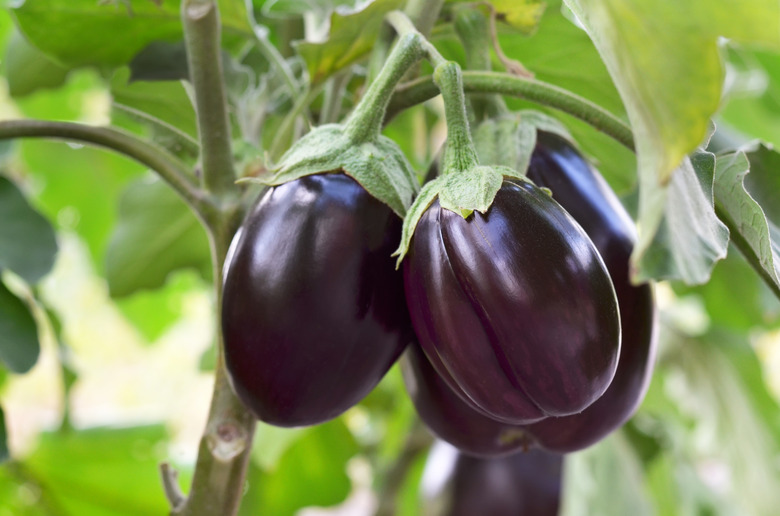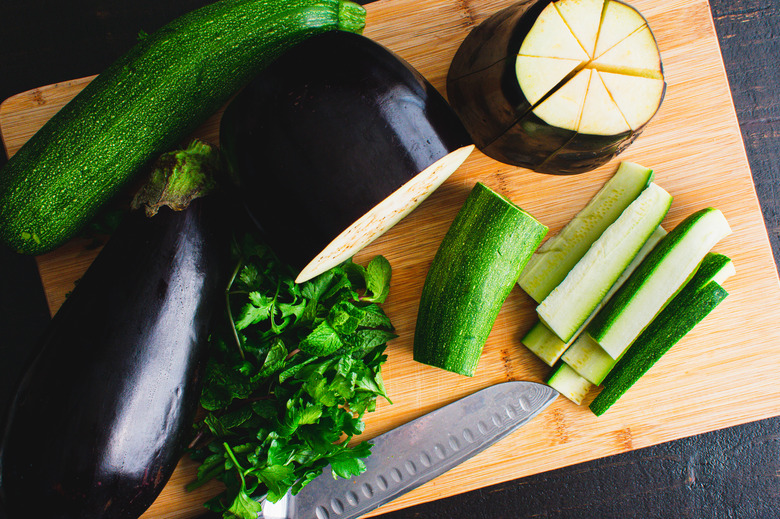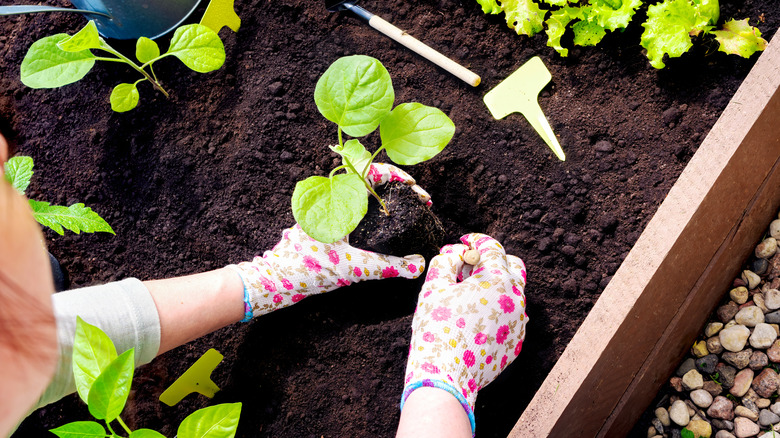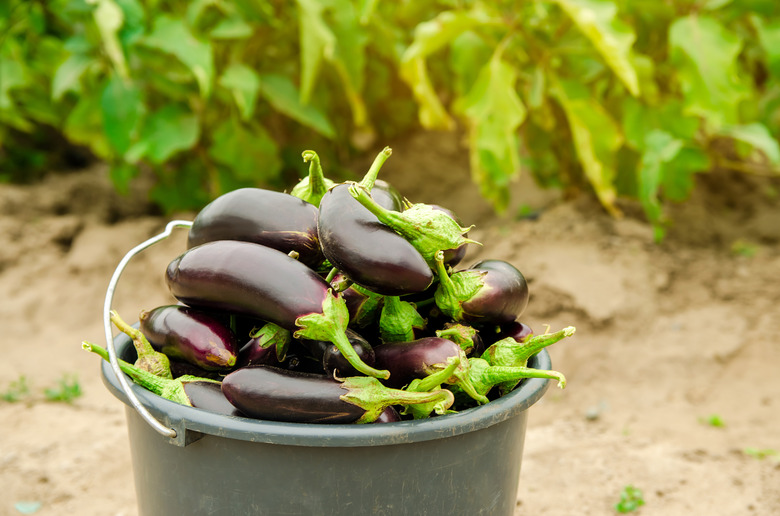How To Grow Eggplant
Many people are surprised to learn that certain vegetables are actually fruits. Tomatoes, peppers and cucumbers are just a few of the fruits masquerading as veggies. In fact, the eggplant (Solanum melongena) is another plant that produces fruit since it's the result of flowers and has seeds. The eggplant is an annual in temperate zones and a short-lived perennial in warm climates across U.S. plant hardiness zones 9 through 12. It hails from the nightshade family (Solanaceae).
The eggplant's color is commonly a shade of deep purple, although there are cultivars that bear fruit in colors including white, lavender, yellow, white, and some that have striped/streaked patterns. 'Fairy Tale' eggplants are small and have charming striped patterns. 'Little Fingers' are also small but display that famed purple color for which eggplants are known. 'Millionaire' eggplants are very slender, and 'Rosa Bianca' eggplants are light purple or almost pink in color. All plants bloom during the summer when grilling eggplant is a favorite activity.
It's not the most cold-hardy plant around; in fact, the eggplant thoroughly enjoys heat during the growing season and thrives between 70 and 85 degrees Fahrenheit. If daytime temperatures drop below 50 degrees, you'll see the flowers drop too. There are eggplant cultivars that can tolerate the cold a bit better, such as 'Elondo' and 'Orient Express.' If you're concerned about your plants, protective row covers are always an option.
Since it's a plant that's a perennial in warm climates, it should come as no surprise that it tolerates droughts well. Plants tend to do better than most other plants during a drought, and some eggplant cultivars do better than others, like 'Nadia.'
Eggplants tend to grow quickly. You can sow eggplant seeds late since they do best when temperatures start heating up outside. The seedlings will grow swiftly, even faster than peppers or tomatoes. You'll see them grow before your eyes when the temperature range falls ideally in that sweet spot of 70 to 85 degrees.
Eager gardeners should know up front that these plants require a bit of TLC. When you plant eggplant, you'll need to anticipate staking them (or using tomato cages) so they don't fall over from the large fruits that will grow on some cultivars later in the season. You should keep the soil moist (a layer of mulch will help that moisture stick), and plants can benefit from a balanced fertilizer, which has equal parts of nitrogen, phosphorus and potassium.
Best Uses for Eggplant
Best Uses for
Eggplant
Whether you're a big fan of eggplant parmigiana or ratatouille, or you like it as a topper on your pizza, eggplant is the perfect accompaniment to pasta, tastes great fried up and can take on the flavor of whatever dish you're serving. Vegetarians like it for its thick, almost meat-like texture, and carnivores devour it for its nutritional value, which is filled with fiber, folate and potassium.
As for where it belongs in your yard, since the eggplant is a big fan of heat, it's only natural that a very sunny spot is where it should be planted— bonus points if the soil is well-draining and outfitted with black plastic mulch in early spring before the growing season begins. An eggplant will be welcome in your vegetable garden or your bed filled with annuals.
You might also want to consider growing eggplant in a container. You can plant one eggplant in a container that holds at least 2 gallons of potting mix. Pair your eggplant with soil that drains easily and a slow-release fertilizer. A potted eggplant could make for an attractive and unexpected addition to your front porch décor. Growing eggplant indoors, however, might be a little tough since they do love the sun so much. It is possible, though, thanks to grow lights. They'll likely be just pretty houseplants for you to admire and may not result in any fruit, however.
How to Grow Eggplant
How to Grow
Eggplant
Starting Eggplant From Seed
You can grow your own eggplant seedlings by starting them from seed. You should start seeds 1/2 inch deep in the soil and 18 to 24 inches apart. The time to germination is typically 10 days to two weeks. If you'd like to start eggplant seedlings indoors, aim for eight to nine weeks before the last spring frost date.
Starting Eggplant From a Seedling
When it comes to transplanting your eggplant seedlings, because eggplants are similar to tomato plants, you can plan on similar requirements for both. Space the eggplant seedlings 18 inches apart in rows that are spaced 30 to 36 inches apart.
You can choose to grow your own seedlings from seed or purchase them from a nursery. The cultivar typically found at nurseries is 'Black Beauty,' an eggplant that's deeply purple or even black in color. Sometimes, you can even find a nonpurple eggplant variety at nurseries — the white eggplant, otherwise known as 'Casper.'
In What Zone Does Eggplant Grow Best?
In What Zone Does
Eggplant Grow Best?
An eggplant can grow in the summer in any zone. However, because the eggplant is a tropical plant, it can't grow in temperatures below 50 degrees. This means that if you live in zones 1 through 8 or 9, you'll need to consider winterizing your plants, which is when you'll bring them indoors.
When Should You Plant Eggplant?
When Should You
Plant Eggplant?
You might be excited to get those eggplant seedlings in the ground, but you should wait until the very last threat of frost. You should also consider soil temperature before you plant, not just air temperature. If you're starting with seeds, the soil temperature should hover around 75 to 85 degrees. Transplants can hit the soil when the air temperature stays above 50 degrees on a regular basis. Since eggplant has a short growing season, you can plant fairly late in the season. June is usually a great month for planting eggplant.
Soil, Sunlight and Water Recommendations for Eggplant
Soil, Sunlight
and Water Recommendations for Eggplant
Eggplants prefer soil that is well-draining and, ideally, sandy in nature. Before planting, you'll want to do a thorough weeding to loosen it up. Remember that plants in general, particularly eggplant, flourish when planted on soil that's rich in organic matter, which means you should include a few inches of compost to help it thrive.
Like beachgoers on vacation, eggplant simply adores sunlight. You'll want to plant your eggplant in full sun, preferably in a south-facing section of your yard to maximize the sun's rays, resulting in sizeable, healthy fruit.
If possible, your eggplants should receive about an inch of water per week, which you can monitor with a nearby rain gauge to see how much rainfall your plants have received. If they're looking droopy, they may need a little more water if it's hot and dry outside. The best times to water are early morning and evening, when it's cool and evaporation rates will be lower.
How to Winterize Eggplant
How to Winterize
Eggplant
If you live in zones 9 or 10 (or warmer), that means you can keep your eggplant plants alive outside year-round as short-lived perennials since they won't frequently face the threat of frost or below-zero temperatures (if you live in a colder climate, your eggplant is an annual that must be re-planted every year). If you live in the right zone and you'd like to overwinter your eggplant, be sure to do a thorough pruning in the fall and give them extra compost. To prune your eggplants, wait until they're fully grown and already have some fruit. Remove any little stems, or "suckers," that are growing between the main stalk and a leaf node.
If there is any possibility of frost, be sure to cover your plants with cotton sheets or burlap pieces that will offer them extra protection. Since they are warm-season plants, they'll slow down over the winter, which means you shouldn't expect additional harvests after the fall.
Winterizing does have its pros: It will speed up next year's harvest and produce fruit faster since the plant is already full grown and can save you money if you don't want to purchase eggplant seedlings or seeds next year. If you had a particularly healthy eggplant that produced a lot of fruit, that's another reason to winterize it for next season. Treat an eggplant like you would any other tropical plant, and the reward will be the fruit it produces again next year.
How to Harvest Eggplant
How to Harvest
Eggplant
How do you know when it's time to harvest eggplant? The skin will offer a clue. The skin should be very glossy and firm, and inside, the seeds should not yet be visible. A ready-to-pick eggplant will be about 1/3 its full size (full size is anywhere from 5 to 12 inches) and dark-purple in color. Also, you can press your thumb against the fruit to see if it's ready to pick. If it springs back, it's not quite ripe; if it leaves a noticeable dent, it's overripe. You'll want that indentation to be somewhere in between.
Pollination can also lend itself to a copious harvest and encourage fruit set. You can either invite bees to pollinate your garden by including pollinator-friendly plants, like cosmos and snapdragons, or you can pollinate the flowers by hand by brushing the stamens with a soft brush.
Common Pests and Other Problems for Eggplant
Common Pests and
Other Problems for Eggplant
There are some pests that plague eggplant. They include flea beetles, Colorado potato beetles and twospotted spider mites. Be sure to take stock of your entire growing situation: the soil, the outdoor temperature and how much you're watering. If your gardening game is lacking in one area, be sure to practice vigilance to bring your plants back to good health.
You can use organic pesticides, or if you prefer a gentler route, you can pick off the pests by hand. Applying a garlic solution may deter some pests, or if you want to head them off at the pass, crop rotation and plastic mulch, which can prevent them from coming up from the soil, can be quite helpful.
Common Diseases for Eggplant
Common Diseases
for Eggplant
Some diseases can impact your eggplant as well:
- Bacterial wilt (Southern wilt): This soil-borne
bacterial disease can lead to wilting leaves. Infected plants must be
removed from your garden. - Verticillium wilt: This is similar to bacterial wilt
except this disease is caused by a fungus in the soil. Again, remove the
infected plants from your garden and plan on crop rotation. - Blossom end rot: This fungal disease also found in
tomatoes is exacerbated by overwatering. Simply water more consistently to avoid
overcompensating for not watering on a regular schedule. - Cercospora leaf spot: This fungal disease causes eggplant to form small yellow lesions on the leaves and stems. To fix
this, control the weeds and avoid overwatering. Also, since the disease can
continue to live in the soil through the winter, it's advised to protect next
year's seedlings with straw or hay.



